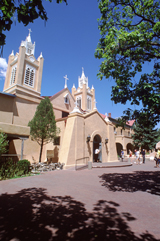City Highlights
by Peter Scholl, Past President
Luther College, IA
If you could get up on the roof of the Hyatt Regency in Albuquerque, to the east you would see the Sandia Mountains, about 12 miles distant, rising around 5,000 feet above the level of downtown. If it is evening, the range may have a pinkish glow—a color that is often said to have inspired early Spanish explorers to name them after the flesh of a watermelon: la sandía. So many place names here are Spanish owing to the long colonial period of Spanish and then Mexican occupation and influence.
If you turned around and faced to the west, you might see the trees lining the Rio Grande—and you could see the horizon about another two miles above the river to see the horizon, topped by long ridge parallel to the river, topped by an escarpment of dark volcanic rock. Beyond the land stretches towards the rocky mesas of Acoma and Laguna pueblos.
Long before the first Spanish explorers passed through this river valley, the ancestors of the Pueblo Indians, who continue to live in their traditional settlements nearby or in the present day city, left thousands of totems and designs carved into those rocks of the western escarpment, and you can view some of them by visiting Petroglyph National Monument, about 7.5 miles from the Hyatt.
The first major European exploration and habitation of the area near Albuquerque occurred in 1540-42, when the Spanish Conquistador Coronado and hundreds in his expedition were the very unwelcome guests of a native settlement known as Kuaua. Ruins and relics are preserved at Coronado Historic Site, 20 miles north of our hotel near the river and the town of Bernalillo.
Long before the Coronado and his soldiers, priests, and their supporters marched north from Mexico in 1540, the river had been a resource, landmark, and pathway for humans since the first prehistoric hunting groups inhabited these lands thousands of years ago. Many Pueblo communities remain near Albuquerque. Isleta Pueblo is on the river 13 miles south of Albuquerque, and Sandia Pueblo is 15 miles north (but there are others within an hour's drive or a little more, including Zia, Laguna, Acoma, Jemez, and Santa Clara).
The Camino Real (King's Road) running from Mexico City northwards into the fringes of Spain's colonial holdings in the region, hugged the Rio Grande for some hundreds of miles, and the empire established Albuquerque as a small military outpost and farming community in 1706. It was named in honor of an early viceroy of New Spain, one of whose titles was the Duke of Alburquerque (the first "r" was later dropped). During the celebration of the 250th anniversary of the founding (it celebrated its tricentennial in 2006), the then current Duke of Alburquerque visited and presented the city with a tapestry. (Albuquerque's nickname is "Duke City" and the local baseball team is the Albuquerque Dukes.)
The Hyatt in the present downtown of Albuquerque is about a mile to the east of where the town was originally centered. The Old Town Plaza with its village square, San Felipe de Neri Church (1793), and other historic buildings still offers an echo of the earlier town, with its Puebloan and Spanish colonial architectual touches still discernible amidst the galleries, curio shops, and restaurants.
The migration of the town center was occasioned by the coming of the railroad around 1880—the line was to run a mile to the east of the old town, so town leaders established a new center. It was a tipping point, and the economic and cultural core of the community shifted rapidly as well—towards commerce, industry, and increased "anglo" immigration and cultural power. In 1880 the city had very few English speakers and was still just a "territory"—New Mexico only gained statehood in 1912 and "New Mexico law grants Spanish a special status."
Central Avenue, just south of the Hyatt, was at first a trolley corridor connecting the old town with the new, and much later was the path through the city of the fabled U.S. Route 66 and a long, long strip of sprawling commercial enterprises, stretching almost to the Sandia mountain pass itself: motels, gas stations, drugstores, pawn shops, fast food joints, trailer courts, car dealerships. But gradually more prestigious institutions began to thrive, especially after World War II—the University of New Mexico, The Sandia National Laboratories, Kirtland Air Force Base, the Lovelace Clinic (where the first astronauts had to show they had the right physical stuff for space flight).
Today Albuquerque is the by far the largest city in New Mexico, with its 555,417 residents making up almost 27% of the New Mexico population of 2.1 million citizens (2012 US Census figures). It has a diverse citizenry and living multicultural heritage. Try to find time to visit some of its special attractions, starting with Old Town, and walking over just a few steps from there to to the Museum of Albuquerque (history, art, and contemporary exhibits) and the New Mexico Museum of Natural History & Science. Just a little farther from the Hyatt you can find the Indian Pueblo Cultural Center and the National Hispanic Cultural Center. The Albuquerque Convention and Visitors Bureau website provides information to these and many other sites and activities and links that offer transportation recommendations.
Welcome to the Land of Enchantment!







